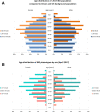Incidence and prevalence of inflammatory bowel disease in Devon, UK
- PMID: 34712463
- PMCID: PMC8515282
- DOI: 10.1136/flgastro-2019-101369
Incidence and prevalence of inflammatory bowel disease in Devon, UK
Abstract
Background and aims: We sought to define temporal changes in prevalence of inflammatory bowel disease (IBD) in East Devon, UK, in order to facilitate service planning over the next 5 years.
Methods: Multiple primary and secondary care databases were used to identify and verify cases. Point prevalence and incidence of IBD were reported in April 2017 and from 2008 to 2016, respectively. Future prevalence and healthcare activity requirements were estimated by linear regression.
Results: Prevalence of ulcerative colitis (UC), Crohn's disease (CD) and inflammatory bowel disease unclassified (IBDU) were 479.72, 265.94 and 35.34 per 100 000 persons, respectively. In 2016, the incidence rates of UC, CD and IBDU were 15.4, 10.7 and 1.4 per 100 000 persons per year, respectively. There were no significant changes in the incidence of CD (p=0.49, R=0.26) or UC (p=0.80, R=0.10). IBD prevalence has increased by 39.9% (95% CI 28.2 to 53.7) in the last 10 years without differences in the rate of change between UC and CD. Overall, 27% of patients were managed in primary care, a quarter of whom were eligible but not receiving endoscopic surveillance. Outpatient clinics, MRI and biologic use, but not helpline calls, admissions, or surgeries increased over and above the change in IBD prevalence.
Conclusions: We report one of the highest prevalence and incidence rates of IBD from Northern Europe. Overall, IBD incidence is static, but prevalence is increasing. We estimate that 1% of our population will live with IBD between 2025 and 2030.
Keywords: epidemiology; inflammatory bowel disease; primary care.
© Author(s) (or their employer(s)) 2021. No commercial re-use. See rights and permissions. Published by BMJ.
Conflict of interest statement
Competing interests: None declared.
Figures





References
LinkOut - more resources
Full Text Sources
Miscellaneous
